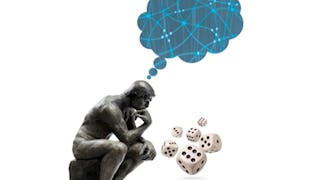Probabilistic graphical models (PGMs) are a rich framework for encoding probability distributions over complex domains: joint (multivariate) distributions over large numbers of random variables that interact with each other. These representations sit at the intersection of statistics and computer science, relying on concepts from probability theory, graph algorithms, machine learning, and more. They are the basis for the state-of-the-art methods in a wide variety of applications, such as medical diagnosis, image understanding, speech recognition, natural language processing, and many, many more. They are also a foundational tool in formulating many machine learning problems.

Enjoy unlimited growth with a year of Coursera Plus for $199 (regularly $399). Save now.

Probabilistic Graphical Models 1: Representation
This course is part of Probabilistic Graphical Models Specialization

Instructor: Daphne Koller
93,779 already enrolled
(1,441 reviews)
Skills you'll gain
Details to know

Add to your LinkedIn profile
12 assignments
See how employees at top companies are mastering in-demand skills

Build your subject-matter expertise
- Learn new concepts from industry experts
- Gain a foundational understanding of a subject or tool
- Develop job-relevant skills with hands-on projects
- Earn a shareable career certificate

There are 7 modules in this course
This module provides an overall introduction to probabilistic graphical models, and defines a few of the key concepts that will be used later in the course.
What's included
4 videos1 assignment
In this module, we define the Bayesian network representation and its semantics. We also analyze the relationship between the graph structure and the independence properties of a distribution represented over that graph. Finally, we give some practical tips on how to model a real-world situation as a Bayesian network.
What's included
15 videos6 readings3 assignments1 programming assignment
In many cases, we need to model distributions that have a recurring structure. In this module, we describe representations for two such situations. One is temporal scenarios, where we want to model a probabilistic structure that holds constant over time; here, we use Hidden Markov Models, or, more generally, Dynamic Bayesian Networks. The other is aimed at scenarios that involve multiple similar entities, each of whose properties is governed by a similar model; here, we use Plate Models.
What's included
4 videos1 assignment
A table-based representation of a CPD in a Bayesian network has a size that grows exponentially in the number of parents. There are a variety of other form of CPD that exploit some type of structure in the dependency model to allow for a much more compact representation. Here we describe a number of the ones most commonly used in practice.
What's included
4 videos2 assignments1 programming assignment
In this module, we describe Markov networks (also called Markov random fields): probabilistic graphical models based on an undirected graph representation. We discuss the representation of these models and their semantics. We also analyze the independence properties of distributions encoded by these graphs, and their relationship to the graph structure. We compare these independencies to those encoded by a Bayesian network, giving us some insight on which type of model is more suitable for which scenarios.
What's included
7 videos2 assignments1 programming assignment
In this module, we discuss the task of decision making under uncertainty. We describe the framework of decision theory, including some aspects of utility functions. We then talk about how decision making scenarios can be encoded as a graphical model called an Influence Diagram, and how such models provide insight both into decision making and the value of information gathering.
What's included
3 videos2 assignments1 programming assignment
This module provides an overview of graphical model representations and some of the real-world considerations when modeling a scenario as a graphical model. It also includes the course final exam.
What's included
1 video1 assignment
Earn a career certificate
Add this credential to your LinkedIn profile, resume, or CV. Share it on social media and in your performance review.
Instructor

Offered by
Explore more from Machine Learning
 Status: Free Trial
Status: Free TrialStanford University
 Status: Free Trial
Status: Free TrialStanford University
 Status: Free Trial
Status: Free TrialStanford University
 Status: Free Trial
Status: Free TrialJohns Hopkins University
Why people choose Coursera for their career




Learner reviews
1,441 reviews
- 5 stars
74.53%
- 4 stars
17.83%
- 3 stars
5.20%
- 2 stars
1.04%
- 1 star
1.38%
Showing 3 of 1441
Reviewed on Mar 24, 2020
really great course! very clear and logical structure. I completed a graphical models course as part of my master's degree, and this really helped to consolidate it
Reviewed on Mar 1, 2018
This subject covered in this course is very helpful for me who interested in inference methods, machine learning, computer vision, and optimization.
Reviewed on Jun 15, 2022
A comprehensive introduction and review of how to represent joint probability distributions as graphs and basic causal reasoning and decision making.
Frequently asked questions
Apply the basic process of representing a scenario as a Bayesian network or a Markov network
Analyze the independence properties implied by a PGM, and determine whether they are a good match for your distribution
Decide which family of PGMs is more appropriate for your task
Utilize extra structure in the local distribution for a Bayesian network to allow for a more compact representation, including tree-structured CPDs, logistic CPDs, and linear Gaussian CPDs
Represent a Markov network in terms of features, via a log-linear model
Encode temporal models as a Hidden Markov Model (HMM) or as a Dynamic Bayesian Network (DBN)
Encode domains with repeating structure via a plate model
Represent a decision making problem as an influence diagram, and be able to use that model to compute optimal decision strategies and information gathering strategies
Honors track learners will be able to apply these ideas for complex, real-world problems
To access the course materials, assignments and to earn a Certificate, you will need to purchase the Certificate experience when you enroll in a course. You can try a Free Trial instead, or apply for Financial Aid. The course may offer 'Full Course, No Certificate' instead. This option lets you see all course materials, submit required assessments, and get a final grade. This also means that you will not be able to purchase a Certificate experience.
When you enroll in the course, you get access to all of the courses in the Specialization, and you earn a certificate when you complete the work. Your electronic Certificate will be added to your Accomplishments page - from there, you can print your Certificate or add it to your LinkedIn profile.
More questions
Financial aid available,





